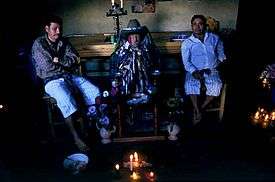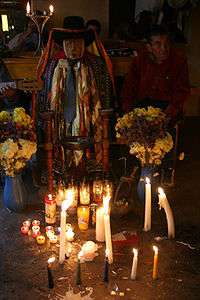Maximón
| Maximón | |
|---|---|
|
Maximón and candles, Santiago Atitlán | |
| Venerated in | Traditionalist Maya Communities |
| Attributes | sunglasses, bandana, colorful garlands |
| Patronage | health, crops, marriage, business, revenge, death |

Maximón (pronounced /mæʃiˈmoʊn/ or /ˈmɒn/), also called San Simón, is a Mayan Deity represented in various forms by the Maya people of several towns in the highlands of Western Guatemala. Oral tradition of his creation and purpose in these communities is complex, diverse, and born of the ancient Maya traditions centuries ago.
Origin
The origins of his creation are not well understood by outsiders who often come to learn of the different Mayan practices, but Maximón is believed to be a form of the pre-Columbian Maya god Mam, blended with influences from Spanish Catholicism. It has been suggested that the name Maximón is a combination of Simón and Max, the Mam word for tobacco. Much of the misunderstanding and mystery surrounding Mam is due to the fact the much of what has been written of him has been done by visitors whose perspectives come from different cultures and faiths which attempt to use these as a foundation to understand him. This is limiting as these do not take into account nor honor the Maya Traditions as being of their own specific, sacred, and Indigenous origins and practices.
Mayan spiritual traditions and customs are lived through oral tradition, ritual, and the carrying out of continual fiestas and traditions. Thus, to understand him and these complex ancient traditions from an external perspective is difficult.
Legend
There are endless legends and oral stories about the creation of Maximon and his role in the community. Many of these are not shared openly by the Traditionalist Maya with visitors. Thus a certain mystery remains and surrounds him. His nature is one that respects and represents both the dark and the light. He is Grandfather, Venerable Wise Man, and Patron of the people. In many of the stories and rituals that surround him one could name his ways as those of a wily and wild "sacred trickster."
Veneration
Where Maximón is venerated, he is represented by an effigy which resides in a different house each year. He is most visible during the annual holy week celebrations and rituals of sacrifice that are carried out to cleanse and regenerate the world Holy Week. During the rest of the year, people of the communities visit Maximón in his chosen residence, where his shrine is always attended by two or more people, called Cofrades, who serve for a full year to care for him in the Cofradia and keep the altar and sacred items in order. Shamans come daily to do rituals on behalf of their clients.
The Cofrades also receive visitors, accept offerings which are used to maintain and enact the ancient customs, celebrations, and rituals. Worshipers offer money, spirits and cigars or cigarettes, candles, incense, and prayers to gain his favor in exchange for good health, good crops, and marriage counseling, amongst other favors. Maximon almost always has a lit cigarette or cigar in its mouth, and in some places, his mouth is formed to allow the attendants to give him spirits to drink. These offerings are a way of "feeding," giving life, and gratitude to Mam.
The financial offerings that are given by other visitors are used to buy candles, provide food for the cofrades, and other members of the community who serve daily, and to carry out the massive fiestas, rituals and costumbres that happen throughout the year.
Maximón is dressed in both Traditional Mayan clothes and modern garments which are often gifted as a gratitude and thanks by those who receive healing and blessings from him. In Santiago Atitlán he is adorned with many colorful scarves, while in Zunil (where he is known as San Simón) he has a very different style, with his face obscured by dark sunglasses and a bandanna. In San Lucas Toliman San Simon lives in a very large community house where other altars are also cared for in one location.
The worship of Maximón treats him not so much as a benevolent deity as is common in other faiths, but rather as a keeper of balance that embraces both the shadow and the light. Many hold high regard and respect of him and do not wish to anger him as they believe that this will throw the world out of balance and cause harm, destruction, or other problems. Some academics also believe him to be a link between the ancient Maya Xibalbá The Underworld and Bitol heart of heaven (Corazón del Cielo). Maya belief and cosmology is continually centered in the belief of Heart of Earth and Heart of Sky. This is how the relationship with the physical and spiritual world is lived and understand. Thus, one is always at the center of the universe (in the heart of everything) and enacting prayers and ceremonies to keep this in balance. The same is true of the aspects of dark and light. These are the continual balancing of day and night being understood as the cycle of all life. Thus, both are needed and one is not bad nor good as is often believed in other traditions or religions.
His continual receiving of offerings of alcohol and cigarettes is done to honor him, feed him, and ask his favor. One most always offer first and then asks to receive. Many of other faiths wish to portray this is sinful. However, this is often derived of a Christian perspective or of those of other faiths. Indeed, these are different ways of worship from many of the conventional ideals of Christian sainthood. While there are some who believe that prayers for revenge, or success at the expense of others, are likely to be granted by Maximón, [1]many also go to simply ask his care, give gratitude, and petition that he grant the blessings they request of him.
In the town of Santiago Atitlán, when clothing of Maximón's is washed during the week before Easter and at other times throughout the year, the water is saved and distributed as holy water to local shop keepers and others in the community, who consume or sprinkle this water in their shop doorways, to ask the blessing of good business.
While Maximon and his home in the Cofradia Santa Cruz is the most known, there are twelve different Ceremonial Houses, or Cofradias in Santiago. Each having their own sacred purpose and function. Each of these are used and cared for daily in the homes of Tz'utujil Maya families. Countless other sacred ritual sites exist throughout the town and surrounding mountains and forests.
Shrines
A Maximón shrine can be visited in San Andrés Xecul, Guatemala, (which is also home to a spectacular 'yellow' church and chapel – there is an indigenous votive offerings area next to the chapel), this also moves from one house to another yearly. In February 2009 the shrine was located behind a grocery and confectionery shop with an admission charge and a further charge for taking photographs. This shrine differs from the one at Santiago Atitlan in that an EPROM chip, presumably from a novelty Christmas card, has been rigged up to speakers and plays a continuous loop of a few bars from three Christmas songs at volume.
See also
Notes
- ↑ Prechtel; Rosales
Further reading
- Prechtel, Martin, The Toe Bone and the Tooth
- Stanzione, Vincent (2003) Rituals of Sacrifice
External links
- Visiting the Evil Saint: Maximon
- An online shrine to Maximón
- Visiting The Maximón – a photo essay
- A Maximon shrine in Antigua, Guatemala
